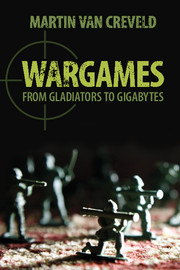Book contents
- Frontmatter
- Contents
- Acknowledgments
- Introduction
- 1 On animals and men
- 2 Games and gladiators
- 3 Trials by combat, tournaments, and duels
- 4 Battles, campaigns, wars, and politics
- 5 From bloody games to bloodless wars
- 6 Enter the computer
- 7 The females of the species
- 8 Conclusions: The mirrors and the mirrored
- Index
- References
6 - Enter the computer
Published online by Cambridge University Press: 05 April 2013
- Frontmatter
- Contents
- Acknowledgments
- Introduction
- 1 On animals and men
- 2 Games and gladiators
- 3 Trials by combat, tournaments, and duels
- 4 Battles, campaigns, wars, and politics
- 5 From bloody games to bloodless wars
- 6 Enter the computer
- 7 The females of the species
- 8 Conclusions: The mirrors and the mirrored
- Index
- References
Summary
Present at creation
Starting in 1945 and lasting for about a decade and a half, a vast wave of change swept over armed conflict as well as the wargames used to simulate it, prepare for it, and, of course, play at it. Largely responsible for the change were two technologies in particular: digital computers and nuclear weapons. Separately and together, so revolutionary were they that those who designed them, developed them, considered ways to employ them, and put them to use (or non-use) could truly claim to have created a new world: one in which humanity, like it or not, will have to live until the end of time.
To speak of computers first, considered from one point of view they have a very long history going back all the way to the ancient Egyptian abacus that Herodotus describes. Considered from another, they only date to the years immediately following World War II when the first multifunction, programmable machines were introduced. Even if visions of such machines that never made it into reality are included, one need go no further back than the “analytical engine” that Charles Babbage and Ada Lovelace built during the first half of the nineteenth century.
Information
- Type
- Chapter
- Information
- WargamesFrom Gladiators to Gigabytes, pp. 230 - 269Publisher: Cambridge University PressPrint publication year: 2013
